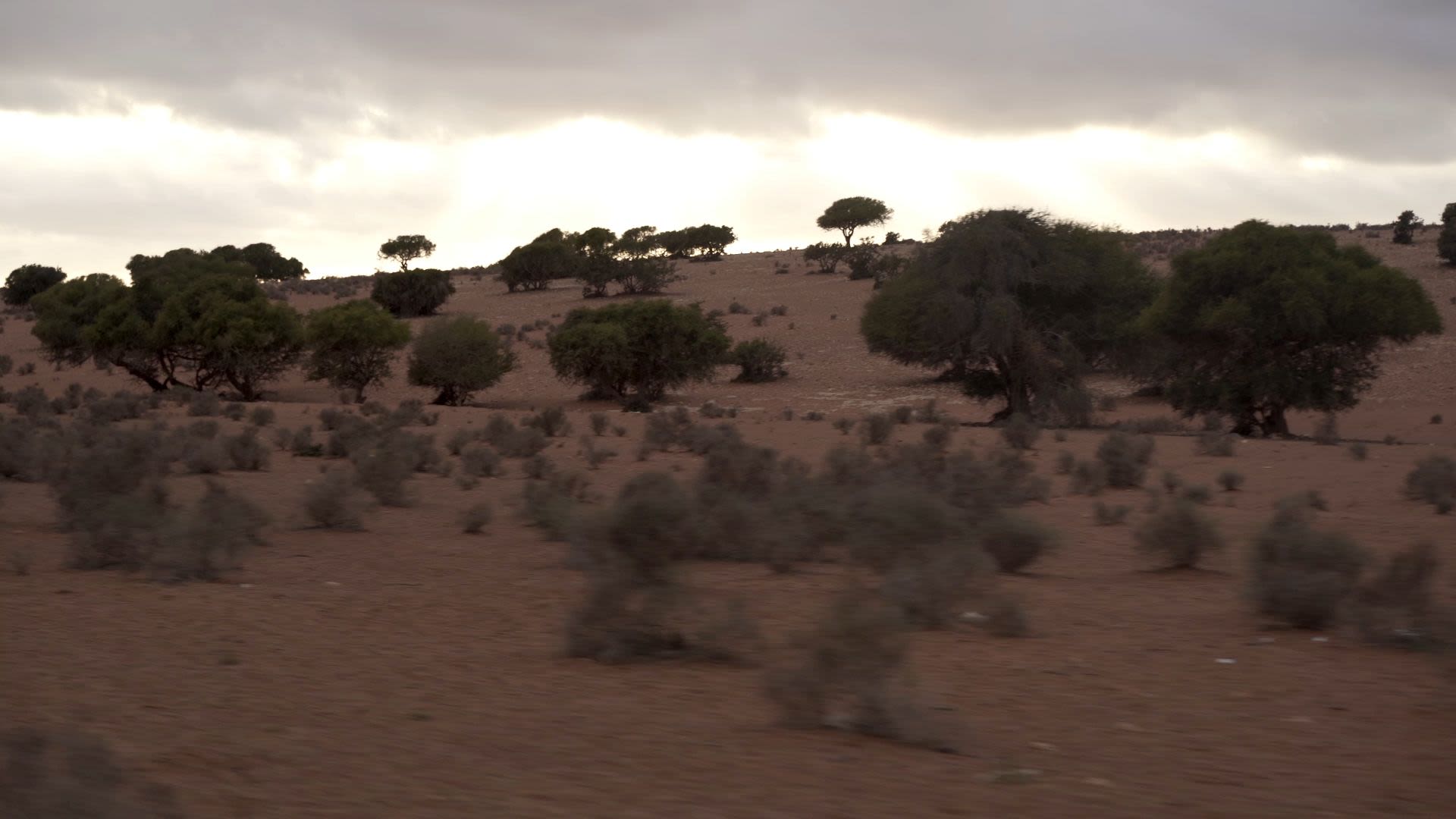Climate-friendly farming preserves argan forests

“When you look at the map of Morocco, in the south you have the desert, in the north you have the majority of our economy, and in the middle, we find the argan biosphere which is the last corridor – and the last barrier – against desertification going north.”
Home to the only biosphere reserve of argan in the world, Morocco is facing a unique challenge. It must preserve its argan forests as a barrier to climate-induced desertification while helping the communities, that depend on these forests for a living, adapt and preserve their cultural heritage.
From picking argan fruits in the forest to processing argan oil, argan production is a community activity led by women. For generations, Moroccan mothers have passed the craft of cracking argan nuts to their daughters. To date, there isn’t a machine in the world that can crack argan nuts for kernel extraction.
Moroccan women farmers, particularly Berbers, in the Souss-Massa region, Essaouira and Guelmim, depend on argan for their livelihood. Many have organized themselves into cooperatives to help each other in the production and marketing of argan products.
Ouahtit Aicha at Tamaynoute Cooperative. Photo: GCF/Angeli Mendoza
Ouahtit Aicha at Tamaynoute Cooperative. Photo: GCF/Angeli Mendoza
“I love argan. I learned to process it by myself for the first time when I was 12. It is my life. I spend all my days in this cooperative. It pays for my purchases; I can buy what my son needs. It helped me build my house. I also get to save money every month.”
The argan biosphere reserve in Morocco. Photo: GCF/Angeli Mendoza
The argan biosphere reserve in Morocco. Photo: GCF/Angeli Mendoza
Argan trees play a key role in mitigating climate change. Photo: GCF/Angeli Mendoza
Argan trees play a key role in mitigating climate change. Photo: GCF/Angeli Mendoza
Harvested argan fruits from the forest. Photo: GCF/Little Big Films
Harvested argan fruits from the forest. Photo: GCF/Little Big Films
Argan seeds for cracking. Photo: GCF/Angeli Mendoza
Argan seeds for cracking. Photo: GCF/Angeli Mendoza
Berber women cracking argan seeds at Tamaynoute Cooperative. Photo: GCF/Angeli Mendoza
Berber women cracking argan seeds at Tamaynoute Cooperative. Photo: GCF/Angeli Mendoza
Processed argan oil at the plant of AAZ Argan in Essaouira. Photo: GCF/Little Big Films
Processed argan oil at the plant of AAZ Argan in Essaouira. Photo: GCF/Little Big Films
Argan oil products displayed at the story of Tamaynoute Cooperative. Photo: GCF/Little Big Films
Argan oil products displayed at the story of Tamaynoute Cooperative. Photo: GCF/Little Big Films
In a way, Argan is Morocco’s tree of life.

In a way, Argan is Morocco’s tree of life. Moroccans traditionally use every part of the fruit, from the skin (used as cattle feed) to the husk (used as combustible material). Globally, its oil is well-known for its health and beauty benefits.
“For the last three decades, we observed that the argan forests are facing so many challenges, mostly related to anthropic intervention,” says Aitlhaj. “Because of the interest of the international markets in the oil, there is a systematic collection of the fruits, so we no longer have the [time for] natural regeneration of the forests.”
“All this is aggravated by the climate change we are experiencing in Morocco. But the argan tree is well suited for severe, dry conditions and for us, the argan tree is the living resource to better adapt to climate change in these areas.”
Under the Green Morocco Plan, and as part of the Government of Morocco’s commitment to reduce its greenhouse gas emissions by 45.5 per cent by 2030, the Government is developing its argan orchards programme.
The argan orchards programme aims to reduce the overharvesting of the argan forests, thereby relieving the anthropic pressure on the trees and allowing for their natural regeneration.
Restoring the degraded argan forest is crucial to removing carbon from the atmosphere, combating desertification, preventing soil erosion, and ensuring the sustainability of livelihoods dependent on the fruits of the argan tree.
Tree-climbing goats in Agadir eating argan fruits. Photo: GCF/Little Big Films
Tree-climbing goats in Agadir eating argan fruits. Photo: GCF/Little Big Films
In addition to overharvesting to meet the global market demand for argan oil products, goats eating a lot of argan fruits, particularly from baby trees, can affect the rejuvenation of the argan forest. Photo: GCF/Angeli Mendoza
In addition to overharvesting to meet the global market demand for argan oil products, goats eating a lot of argan fruits, particularly from baby trees, can affect the rejuvenation of the argan forest. Photo: GCF/Angeli Mendoza
Berber women harvesting argan fruits from the forest. Photo: GCF/Little Big Films
Berber women harvesting argan fruits from the forest. Photo: GCF/Little Big Films
For generations, harvesting argan from the forest has been a community activity led by women. Photo: GCF/Angeli Mendoza
For generations, harvesting argan from the forest has been a community activity led by women. Photo: GCF/Angeli Mendoza
Together at a neighbour's house, these women demonstrate their skills in cracking nuts and making argan oil. Photo: GCF/Angeli Mendoza
Together at a neighbour's house, these women demonstrate their skills in cracking nuts and making argan oil. Photo: GCF/Angeli Mendoza
By financing 80% of the total investment cost, the Green Climate Fund (GCF) is scaling up Morocco’s argan orchards programme. GCF’s grant support has been crucial to de-risking this project. Although pilot argan nurseries have successfully demonstrated proof of concept, there is a lack of available funding due to competing demands for mitigation projects in other sectors, including the energy industry. Moreover, the traditional banking system has not yet adapted its funding mechanisms because of the lack of past successful and profitable investments of this nature.
Under the programme, local communities are receiving training on how to properly cultivate argan trees in orchards on private lands. The target of the programme is to plant 10,000 hectares of argan tree orchards, intercropped with medicinal and aromatic plants.
The programme will also provide support to the cooperatives to improve their argan fruit collection, storage and processing capabilities and infrastructure. This will empower them to produce products that meet international standards which can be sold at profitable prices.
Furthermore, the GCF grant will be used to establish the Argan National Center of Excellence which will channel all the scientific research done by various scientists and organizations on argan and promote the cultural heritage of the argan tree.
Ultimately, the argan orchards programme helps to preserve the forests, strengthens the capacity of vulnerable communities to adapt to climate change, and provides a sustainable model for the argan industry.

“That’s why we are implementing the project. We want to plant more argan trees, we want to preserve what we have – the natural forest – and we want [the] people who depend on the argan business to make better income, better living, so they can preserve the forests and they can look after the forests.”


















